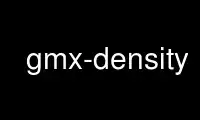
This is the command gmx-density that can be run in the OnWorks free hosting provider using one of our multiple free online workstations such as Ubuntu Online, Fedora Online, Windows online emulator or MAC OS online emulator
PROGRAM:
NAME
gmx-density - Calculate the density of the system
SYNOPSIS
gmx density [-f [<.xtc/.trr/...>]] [-n [<.ndx>]] [-s [<.tpr>]]
[-ei [<.dat>]] [-o [<.xvg>]] [-b <time>] [-e <time>]
[-dt <time>] [-[no]w] [-xvg <enum>] [-d <string>]
[-sl <int>] [-dens <enum>] [-ng <int>] [-[no]center]
[-[no]symm] [-[no]relative]
DESCRIPTION
gmx density computes partial densities across the box, using an index file.
For the total density of NPT simulations, use gmx energy instead.
Option -center performs the histogram binning relative to the center of an arbitrary
group, in absolute box coordinates. If you are calculating profiles along the Z axis box
dimension bZ, output would be from -bZ/2 to bZ/2 if you center based on the entire system.
Note that this behaviour has changed in GROMACS 5.0; earlier versions merely performed a
static binning in (0,bZ) and shifted the output. Now we compute the center for each frame
and bin in (-bZ/2,bZ/2).
Option -symm symmetrizes the output around the center. This will automatically turn on
-center too. Option -relative performs the binning in relative instead of absolute box
coordinates, and scales the final output with the average box dimension along the output
axis. This can be used in combination with -center.
Densities are in kg/m^3, and number densities or electron densities can also be
calculated. For electron densities, a file describing the number of electrons for each
type of atom should be provided using -ei. It should look like:
2
atomname = nrelectrons
atomname = nrelectrons
The first line contains the number of lines to read from the file. There should be one
line for each unique atom name in your system. The number of electrons for each atom is
modified by its atomic partial charge.
IMPORTANT CONSIDERATIONS FOR BILAYERS
One of the most common usage scenarios is to calculate the density of various groups
across a lipid bilayer, typically with the z axis being the normal direction. For short
simulations, small systems, and fixed box sizes this will work fine, but for the more
general case lipid bilayers can be complicated. The first problem that while both
proteins and lipids have low volume compressibility, lipids have quite high area
compressiblity. This means the shape of the box (thickness and area/lipid) will fluctuate
substantially even for a fully relaxed system. Since GROMACS places the box between the
origin and positive coordinates, this in turn means that a bilayer centered in the box
will move a bit up/down due to these fluctuations, and smear out your profile. The easiest
way to fix this (if you want pressure coupling) is to use the -center option that
calculates the density profile with respect to the center of the box. Note that you can
still center on the bilayer part even if you have a complex non-symmetric system with a
bilayer and, say, membrane proteins - then our output will simply have more values on one
side of the (center) origin reference.
Even the centered calculation will lead to some smearing out the output profiles, as
lipids themselves are compressed and expanded. In most cases you probably want this (since
it corresponds to macroscopic experiments), but if you want to look at molecular details
you can use the -relative option to attempt to remove even more of the effects of volume
fluctuations.
Finally, large bilayers that are not subject to a surface tension will exhibit undulatory
fluctuations, where there are 'waves' forming in the system. This is a fundamental
property of the biological system, and if you are comparing against experiments you likely
want to include the undulation smearing effect.
OPTIONS
Options to specify input files:
-f [<.xtc/.trr/...>] (traj.xtc)
Trajectory: xtc trr cpt gro g96 pdb tng
-n [<.ndx>] (index.ndx) (Optional)
Index file
-s [<.tpr>] (topol.tpr)
Portable xdr run input file
-ei [<.dat>] (electrons.dat) (Optional)
Generic data file
Options to specify output files:
-o [<.xvg>] (density.xvg)
xvgr/xmgr file
Other options:
-b <time> (0)
First frame (ps) to read from trajectory
-e <time> (0)
Last frame (ps) to read from trajectory
-dt <time> (0)
Only use frame when t MOD dt = first time (ps)
-[no]w (no)
View output .xvg, .xpm, .eps and .pdb files
-xvg <enum>
xvg plot formatting: xmgrace, xmgr, none
-d <string> (Z)
Take the normal on the membrane in direction X, Y or Z.
-sl <int> (50)
Divide the box in this number of slices.
-dens <enum> (mass)
Density: mass, number, charge, electron
-ng <int> (1)
Number of groups of which to compute densities.
-[no]center (no)
Perform the binning relative to the center of the (changing) box. Useful for
bilayers.
-[no]symm (no)
Symmetrize the density along the axis, with respect to the center. Useful for
bilayers.
-[no]relative (no)
Use relative coordinates for changing boxes and scale output by average dimensions.
KNOWN ISSUES
· When calculating electron densities, atomnames are used instead of types. This is bad.
Use gmx-density online using onworks.net services
